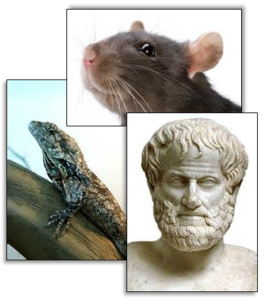 You don’t have to be a zombie to be fascinated by human brains. We humans have been contemplating our cranial contents for centuries, and new theories are lofted constantly. Happily for us, emerging techniques in neuroscience reveal staggering new insights with stunning regularity. And as usually happens in research, new evidence debunks old “truths.”
You don’t have to be a zombie to be fascinated by human brains. We humans have been contemplating our cranial contents for centuries, and new theories are lofted constantly. Happily for us, emerging techniques in neuroscience reveal staggering new insights with stunning regularity. And as usually happens in research, new evidence debunks old “truths.”
Here’s a good example of how our understanding evolves as research marches on. For years, well-meaning authors, speakers, and journalists have described the brain as comprising three distinct layers that serve different functions and represent evolutionary bursts of development. These descriptions are usually drawn from the work of Paul D. MacLean (1913 – 2007), neuroscientist and author of The Triune Brain in Evolution (1990). He identified and characterized the three strata as:
- Protoreptilian formation (basal ganglia, midbrain, brainstem)—aka lizard brain
- Paleomammalian formation (limbic system, composed of the amygdala, hypothalamus, hippocampal complex, etc.)—aka early mammal brain
- Neomammalian formation (cerebral neocortex)—aka modern primate brain
[FYI, this is the source of my titular joke for this post: A lizard, a rat, and a logician walk into a bar… and they’re all actually the same guy! Okay, it’s not a great joke. But it made you look!]
In this Triune Brain model—especially as deployed by non-scientists and motivational speakers—the layers are presented as being clearly separate from each other, operating semi-autonomously.
 The Lizard Brain concept in particular caught the attention of the aforementioned thinkers and writers in the 1990s, and is still cited as a driving force behind much less-than-desirable human behavior. It’s lovely to blame some inner ancient anatomical structure for (as one author puts it) our “fight, flight, feeding, fear, freezing-up, and fornication.”
The Lizard Brain concept in particular caught the attention of the aforementioned thinkers and writers in the 1990s, and is still cited as a driving force behind much less-than-desirable human behavior. It’s lovely to blame some inner ancient anatomical structure for (as one author puts it) our “fight, flight, feeding, fear, freezing-up, and fornication.”
Fast-forward a couple of decades, though, and you’ll find that poor ol’ McLean’s theories have been largely left in the dust. (Although he deservedly gets credit for his 1952 publication that recognized for the first time that the limbic system is a major functional system in the brain.) As further research has consistently shown, all of the brain’s components are very tightly coupled, and interactions are far more complex than early investigators could discern. While brain functions are often concentrated in one area or another, you won’t typically find isolated layers acting completely alone.
 Of course, those decades we so cavalierly fast-forwarded through just happen to be pretty spectacular decades for brain research. As a matter of fact, 1990 through 2000 was actually proclaimed to be The Decade of the Brain by then-President George H. W. Bush. It was also in the 1990s that neuroscience enjoyed a flurry of breakthroughs in finding non-invasive tools and techniques for watching the brain while it is working—a nifty trick when you consider just how formidable a barrier our skulls provide.
Of course, those decades we so cavalierly fast-forwarded through just happen to be pretty spectacular decades for brain research. As a matter of fact, 1990 through 2000 was actually proclaimed to be The Decade of the Brain by then-President George H. W. Bush. It was also in the 1990s that neuroscience enjoyed a flurry of breakthroughs in finding non-invasive tools and techniques for watching the brain while it is working—a nifty trick when you consider just how formidable a barrier our skulls provide.
The star of the new technology show is generally perceived to be the
functional MRI (Magnetic Resonance Imaging) device, along with other cool toys, such as positron emission tomography (PET) scans and near infrared spectroscopy (NIRS). All of these techniques rely on tracking blood flow and oxygen use as indicators of brain activity.
Why then, you may ask, did we just invest valuable time in pondering a theory that has already been debunked?
 Because it happens all the time, and I want arm you with this understanding before we plunge forward any further in our quest together to unify current thinking in psychometrics, neuroscience, and positive psychology: “current thinking” is always a moving target.
Because it happens all the time, and I want arm you with this understanding before we plunge forward any further in our quest together to unify current thinking in psychometrics, neuroscience, and positive psychology: “current thinking” is always a moving target.
In this blog, I pledge to use the most up-to-date, reliable information I can find. But even as each post is posted, dedicated scientists somewhere are striving to challenge and build on the ideas it contains. That’s how humankind expands our body of knowledge. And it’s also how we so easily get left behind, working with stale data.
Therefore, Gentle Reader, be alert whatever you read or hear “the latest research shows…” or “scientists have just discovered that…” or “experts say…” and so on. Writers operating from the best of intentions can overstate, understate, use an obsolete source, take out of context, and/or completely mangle research findings, especially preliminary data with sexy implications. Even here. Especially here, given that I am merely a humble business writer, and not a credentialed scientist.
With that clearly understood and agreed between us, then, let’s finally start feasting on the scintillating science available—so far today, anyway—about how brain biology becomes the basis of the unique Self that you are!
P.S. Even for our 50,000-foot view of brain science, you may find it helpful to know a little something about the structures of the brain and their various functions. Check out this 14-minute video to help you master the basics: The Brain, from BozemanScience.com.
~~~